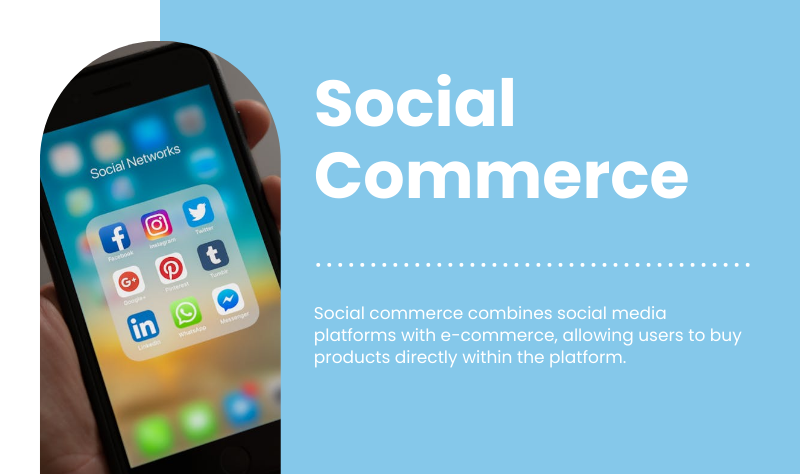What Is Social Commerce?
Social commerce refers to the use of social media platforms to promote and sell products and services directly within the platform, streamlining the buying process by integrating e-commerce capabilities with social interactions. Unlike traditional e-commerce, where users are redirected to a separate website, social commerce allows consumers to discover, evaluate, and purchase without ever leaving the app.
Platforms like Instagram, TikTok, Facebook, and Pinterest have all embraced this model with features like in-app checkout, product tagging, live shopping events, and shoppable posts. This evolution from mere social networking to integrated shopping experiences has created fertile ground for marketers to reach, engage, and convert audiences in entirely new ways.Social commerce involves selling products and services directly on social media platforms, integrating e-commerce features into social interactions to simplify purchasing. This differs from traditional online shopping where buyers navigate to external websites. Social platforms such as Instagram, TikTok, Facebook, and Pinterest now offer in-app checkout, product tagging, live shopping, and shoppable posts. This shift from social networking to integrated shopping provides marketers with new avenues to connect with, involve, and convert consumers.
The Accelerated Proliferation of Social Commerce
Social commerce is experiencing a significant surge in popularity.
Social commerce is no longer a buzzword—it’s a full-blown revolution. According to market analysts, global sales via social platforms are expected to surpass $2 trillion within the next few years. Driving this shift are three key factors:
- Mobile-first consumers who prefer seamless, fast shopping experiences.
- Influencer marketing which shortens the buyer’s journey from discovery to decision.
- AI-driven personalization that customizes product recommendations in real-time.
With billions of active users across social media, these platforms have become not just places of connection, but full-fledged retail ecosystems.
Key Social Platforms Leading the Charge
Instagram’s Shop tab, product tags, and checkout options make it a front-runner in the social commerce space. With its visual-first format, it’s ideal for fashion, beauty, and lifestyle brands.
TikTok
TikTok’s integration of TikTok Shop, paired with viral content and algorithmic magic, is fueling impulse buys at scale. It’s especially powerful for niche and Gen Z-focused products.
Still a dominant force, Facebook offers features like Marketplace, Shops, and Live Shopping, targeting an older demographic and local buyers.
With a user base geared toward discovery and planning, Pinterest’s Buyable Pins and Shopping Ads drive high-intent purchases—particularly in home decor, fashion, and DIY.
Why Social Commerce Is a Game-Changer for Retail Marketers
Social commerce changes the retail marketing landscape in several significant ways:
1. Seamless Path to Purchase
Traditional funnels are becoming obsolete. With social commerce, discovery, evaluation, and conversion happen in a single flow, often in seconds. This reduces friction and cart abandonment rates dramatically.
2. Enhanced Social Proof
Likes, comments, shares, and influencer endorsements serve as real-time testimonials, building consumer confidence and accelerating decisions.
3. Data-Rich Insights
Social platforms provide marketers with granular analytics—click-through rates, engagement metrics, demographic breakdowns—that inform future campaigns and product iterations.
4. Visual Storytelling
Through Stories, Reels, and carousels, brands can craft compelling narratives around their products, making them more relatable and desirable.
5. Community Building
Social commerce fosters two-way communication. Marketers can engage with customers via polls, DMs, and comments, driving brand loyalty and advocacy.
The Influence of User-Generated Content (UGC)
UGC is the heartbeat of social commerce. Whether it’s unboxing videos, tutorials, or customer reviews, content created by users is often more trusted and influential than branded advertising.
Retail marketers should encourage UGC by:
- Launching hashtag campaigns
- Featuring customer content in their feeds
- Offering incentives like discounts or giveaways
This not only builds trust but also provides a continuous stream of content to fuel product discovery.
Influencer Marketing and Live Commerce
Influencer marketing has evolved from brand awareness to full-on conversion tool. Micro and nano-influencers, with their niche, highly engaged audiences, are proving especially effective for social commerce.
Meanwhile, live commerce—where hosts demo products in real time—is rapidly gaining traction. Platforms like Instagram Live and TikTok Live enable brands to:
- Answer questions instantly
- Show product use cases
- Offer time-sensitive deals to create urgency
Retail marketers can capitalize on this format to humanize their brand and create interactive shopping experiences.
Optimizing Product Pages for Social Platforms
Unlike traditional e-commerce, social commerce demands bite-sized, visually compelling content. Here’s how to optimize:
- High-quality images and videos tailored to each platform’s format
- Clear, concise product descriptions
- Tagging products in Stories, Reels, and Posts
- Incorporating reviews and ratings directly within the post
This not only increases conversions but also enhances your visibility in the platform’s algorithm.
Data, Privacy, and Trust
As commerce moves onto social platforms, concerns about data privacy and platform dependency grow. Consumers expect transparency, while brands must comply with data regulations like GDPR and CCPA.
Retail marketers must:
- Be upfront about data usage
- Implement ethical retargeting strategies
- Stay updated on platform policies and algorithm changes
Building trust is non-negotiable in an era where consumer skepticism is high.
Challenges Retail Marketers Face
Despite the promise, social commerce isn’t without its hurdles:
- Platform algorithm changes can affect visibility and reach.
- High competition makes standing out harder.
- Over-reliance on influencers can backfire if partnerships aren’t authentic.
To mitigate these risks, marketers need to diversify their strategies, foster owned communities, and continuously test content formats.
Integrating Social Commerce into Broader Marketing Strategies
Social commerce should not exist in a silo. Instead, it should be integrated with your broader omnichannel marketing strategy. This means:
- Retargeting social shoppers via email or SMS
- Using social insights to inform website content
- Syncing social product catalogs with your e-commerce platform
Also, integrating internal linking across your owned content (like blog posts and landing pages) ensures SEO value is preserved and users stay within your brand ecosystem longer. For instance, optimizing internal linking can help drive traffic from high-performing content to your key product or offer pages.
Measuring Success: Key Metrics to Track
To understand ROI, retail marketers must look beyond vanity metrics. Key indicators include:
- Click-through rate (CTR) on product tags
- Conversion rate from in-app purchases
- Engagement rate (likes, shares, comments)
- Customer acquisition cost (CAC)
- Repeat purchase rate from social platforms
Tools like Meta Business Suite, TikTok Analytics, and third-party dashboards make tracking easier than ever.
Future Trends in Social Commerce
Here’s what the next wave of social commerce looks like:
- AR Try-ons: Platforms like Snapchat and Instagram are introducing augmented reality features to let users “try” products before buying.
- AI-Powered Recommendations: Hyper-personalization will drive even higher conversions.
- Voice and Chat Commerce: Shopping via smart assistants or in-app bots is on the horizon.
- Decentralized Platforms: Web3 could birth new platforms where users own their data and influence monetization more directly.
Retail marketers need to stay agile and proactive, ready to pivot as these innovations become mainstream.
Social commerce is no longer optional—it’s imperative. It shortens the buyer journey, humanizes brands, and unlocks new revenue streams. For retail marketers, it presents both a challenge and an incredible opportunity to meet consumers where they already spend their time.
By embracing platform-specific strategies, leveraging UGC and influencers, and ensuring their content is both engaging and shoppable, marketers can drive growth, loyalty, and long-term success in the ever-evolving digital retail landscape.








